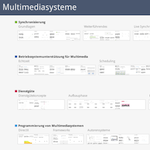Modellbasierte Entwicklung von Interaktionsanwendungen

This thesis describes how the behavior of interactive applications can be modeled by using vanilla UML 2.2. No extensions are needed, allowing the user to keep their preferred modeling tools. An architecture for multimodal applications, the multimodal arch, is presented and implemented. The result is an easily extensible and scalable software framework. Its application is demonstrated with two prototypes, employing speech, two parallel GUIs and haptic input.
Author: Guido de Melo
Referees: Michael Weber, Helmut Partsch
Context: Promotion in Informatik
Video MP3-Player, Video Coffee-Machine
Website (incl. videos and thesis pdf)
The NAV-E System

The NAV-E system is a navigation system for pedestrians in outdoor environments. Its design was driven by the special needs of people suffering from dementia. The system is supposed to help dementia patients to complete spatially distributed tasks and thus contribute to the long-term goal of them living independently in their familiar environment for several months longer. Apart from an easy user interface, particular emphasis was put on the high precision of the positioning technique so that exact instructions could be given at the right moment. Among other things, this was accomplished by a novel method of partitioning the road system.
Author: Oliver Knörzer
Supervisors: Prof. Michael Weber, Prof. Wolfgang Minker
Advisors: Frank Honold, Felix Schüssel
Context: diplom thesis 2010
Multifunctional and Adaptive Meal Preparation Facility (MAMPF)

Mampf is a stove equipped with a computer to control the burners and interact with the user. On the one hand, it can lead a user through a recipe, will automatically adjust the appropriate heating for a pot and enables non-proficient cooks to cook as professionals. On the other hand it is possible to use it manually as a traditional stove, added with timing functionality and free positioning of a pot. Therefore, MAMPF is intended to expand the kitchen with computer aided tools, but will appear as an embedded system, thus trying to keep it as simple and easy to use as a normal stove.
Team: Timo Müller, Oliver Stamm, Fabian Groh, Sven Reichel, Steffen Scherle
Adviser: Björn Wiedersheim
Context: Elective course Ubiquitous Computing 2009/2010
Distributed Recon/Reporting Transceiver Toolkit (diretto)

The primary goal of the diretto project is the creation of an extensible infrastructure and easy-to-use toolset for distributed on-site media reporting and collaborative event coverage in realtime. It empowers collocated users to participate dynamically, but also integrates remote users. The design of the platform takes scalability and performance into account and enables other developers to integrate additional extensions and complementary features easily. Additionally, it offers client applications for various internet-enabled devices as well as a solution for embedded photography reporting using regular digital cameras by introducing intermediate uplink nodes.
Team: Benjamin Erb, Stefan Kaufmann, Christian Koch
Advisers: Florian Schaub, Stefan Dietzel
Context: Elective course Ubiquitous Computing 2009/2010
TTable PP

The project TTablePP addresses the integration of mobile devices and multitouch tables. The contents and services of mobile devices are shown on a graphical user interface on the surface of a multitouch table. They can be experienced using the enhanced interaction possibilites of common multitouch tables. At the moment, possible services are the display, playback and sharing of files, images, music, videos or contacts and the ability to write short messages. New services can easily be added with the help of a plugin mechanism.
Team: Markus Dibo, Sebastian Jehle, Ruben Lang, Rainer Mösle
Adviser: Bastian Könings
Context: Elective course Ubiquitous Computing 2009/2010
Videmus - Augmented Reality for Mobile Devices

The Videmus project allows browsing through the Augmented Reality by using an Android-capable mobile device. Virtual objects are displayed on your device's display and are seamlessly integrated into a live picture of your environment. Furthermore, these virtual objects can be directly manipulated by users and shared with others as Videmus allows to insert your own content into the Augmented Reality. Imagine a world where a piece of information is no longer associated with an abstract keyword but connected with a place in the real world. Videmus opens a window to this world!
Team: David Herges, Alexander Nassal, Benjamin Resch
Advisor: Boto Bako
Context: Anwendungsfach Ubiquitous Computing 2009/2010
Improving the credibility of routing decisions in navigation systems

Users often trust navigation systems blindly, which can lead to serious consequences. Drivers are even willing to perform a U-Turn on the highway, if the navigation system requests to do so. In this thesis we identified credibility problems and developed several approaches to improve credibility of routing decisions in navigation systems and to guarantee a better interaction between driver and system.
Author: Markus Hipp
Supervisors: Michael Weber, Frank Kargl
Advisor: Florian Schaub
Context: Diplom thesis (2010)
Interaktive Musikbibliothek

Die Intention bei diesem Projekt war es, eine neue Möglichkeit zu finden, mit der man die eigene Musikbibliothek durchforschen und neu entdecken kann. Dies sollte erreicht werden indem die einzelnen Titel in Relation zueinander dargestellt werden.
Team: Christian Bihl, Andreas Kern
Kontext: Anwendungsfach Interaktive Systeme 2010
Interaktives Skript zur Vorlesung Multimediasysteme

Die Vorlesungsinhalte der Multimediasysteme wurden multimedial aufbereitet und mit Interaktivität angereichert um Studenten beim Lernen zu unterstützen.
Team: David Langer, Andreas Kern, Andreas Schneider, Michael Strauß
Kontext: Anwendungsfach Interaktive Systeme 2010
Projekt Parkhaus

Drei Neobachtungsarten mit der Kamera werden exemplarisch an einem alltgäglichen Vorgang (hier: Einparken im Parkhaus) untersucht. Der selbe Vorgang wird mit passiver (unbewegter), aktiver (bewegter) sowie teilnehmender (mitfahrender) Kamera abgebildet, was dem Betrachter eine jeweils andere Wahrnehmung nahelegt.
Team: Benjamin Schierlinger, Martin Fröchtenicht, Mitar Radic, Willy Weise, Benjamin Rudner
Kontext: Anwendungsfach Interaktives Video 2010
